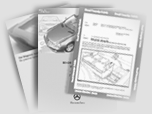
Diagnostic Manual, Body and Accessories,
Volume 6
Diagnosis - Function Test
 CAUTION! CAUTION!
Injury hazard from pinching and crushing, in extreme cases extremities can even be severed when caught in the mechanism.
When working on components activated via hand, electrically via motors, hydraulically, pneumatically via linkages, it is possible that severe injury can result in the severing, pinching, or crushing of body parts.
Do not allow any body parts to be in the general area of the moving components.
Protective measures:
- Supervise work.
- Do not reach into the moving mechanism at any time during any tests.
- Keep away from the moving mechanism of components which are being activated via the HHT and or directly via circuit 30.
- Ensure that all test cables are of sufficient length.
 CAUTION! CAUTION!
Risk of severe injury, during repair work the roll bar may be deployed (extended) rapidily, ensure that no persons are within the deployment radius of the roll bar during testing and repair.
Fully extend the roll bar prior to performing any repair work. Keep body parts away from the roll bar deployment radius and its mechanism.
Be aware that when performing diagnostic or repair work on the Power Soft Top Control Module (N52) (roll over sensors integrated in N52!), the roll bar may deploy due to unintentional activation. An automatic deployment of the roll bar may occur within 1 hour after the ignition OFF. Therefore, turning the ignition OFF is not sufficient, follow Protective Measures noted below:
Protective measures:
- Supervise work.
- Prior to starting work, extend the roll bar completely.
- If due to a technical difficulty, it is not possible to extend the roll bar completely, disconnect the vehicle battery (G1).
- Do not allow any body parts to be in the general area of the deployment radius of the roll bar mechanism
 CAUTION! CAUTION!
Risk of severe injury, to eyes and skin from escaping high pressure hydraulic fluid spray.
Risk of poisoning due to consumption of hydraulic fluid.
Depressurize the hydraulic system prior to performing repair work
Wear protective clothing and safety goggles.

In order to prevent damage to control modules, disconnect/connect
control module connectors only with CIRCUIT 15R: OFF.

When performing activations using the HHT, the Power Soft Top Test Connector (X11/12) must be grounded to vehicle chassis.
After activation are performed, the established ground connection MUST be removed.

Power Soft Top Test Connector (X11/12) is located near (X11/14).
|
Preparation for Test:
1. Battery voltage 11 - 14 V,
2. Fuses are OK.

Connect the battery charger when performing the tests.

In order to make accurate visual inspection for oil loss from the hydraulic system, the trim panels covering the hydraulic components and rear seat assembly must be removed.
If deployment problems occur in conjunction with the power soft top, review of the power soft top section in the diagnostic manual should be undertaken.
|
| Test step/Test sequence |
Test condition |
Nominal value |
Possible cause/Remedy 1) |
| 1.0 Indicator lamp in RB switch (S83) (manual operation) |
Ignition: ON
Engine : OFF
Engine: At idle
|
Indicator lamp in S83 illuminated.
Indicator lamp in S83 goes out. |
 12 12 |
| 2.0 Extend roll bar via RB switch (S83) |
Ignition: ON
Roll bar: Retracted
Press S83 in direction "extend" and hold pressed. |
Indicator lamp in S83 illuminates.
Roll bar extends (slowly).
|
 12 12 |
| 3.0 Indicator lamp in RB switch (S83) (manual operation) |
Ignition: OFF
Roll bar: Extended
Ignition: ON |
Indicator lamp in S83 illuminated.
|
 12 12 |
| 4.0 Retract roll bar via RB switch (S83) |
Ignition: ON
Roll bar: Extended
Press S83 in direction "retract" and hold pressed. |
Indicator lamp in S83 illuminated.
Roll bar retracts.
|
 12 12 |
1) Observe Preparation for Test, see  22. 22. |
|


 Printable version
Printable version


 Printable version
Printable version